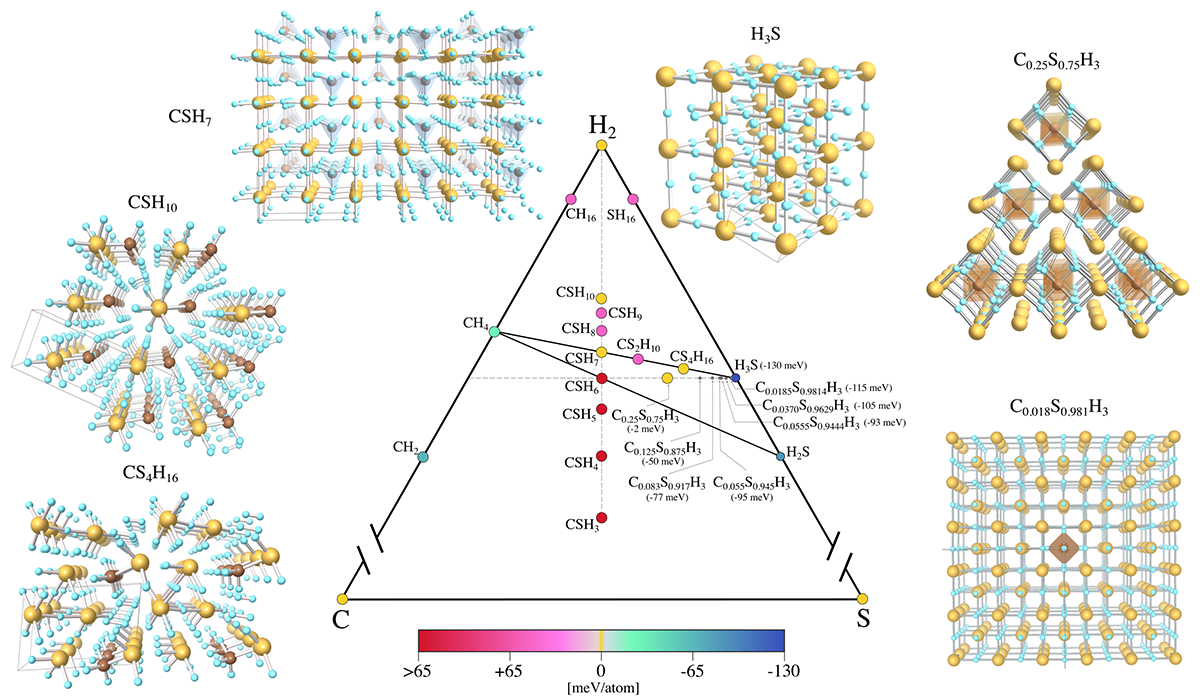PC4-2
Absence of conventional room-temperature superconductivity at high pressure in carbon-doped H3S
*Tianchun Wang1, Motoaki Hirayama1,2, Takuya Nomoto1, Takashi Koretsune3, Ryotaro Arita1,2, José A. Flores-Livas4
- Department of Applied Physics, University of Tokyo1
- CEMS, RIKEN2
- Department of Physics, Tohoku University3
- Dipartimento di Fisica, Università di Roma La Sapienza4
Recently, it has been reported that room-temperature superconducticity with Tc ~ 280 K emerges in cabonaceous sulfur hydride (C-S-H) systems under high pressure up to 270 GPa [1]. Since their atomic configuration is still not determined, we explore a variety of crystal structures in a C-S-H convex hull and discuss the stability of candidate structures of C-S-H ternary compounds [2].
Meanwhile, based on ab initio calculations using the McMillan-Allen-Dynes formula, it has been recently shown that carbon-doped H3S with a doping level of around 5% could be a promising candidate for the room-temperature superconductor [3,4]. While the McMillan-Allen-Dynes is based on the constant DOS approximation, in this work we perform ab initio Migdal-Eliashberg calculation considering the significant energy dependence of the van Hove singulartiy around the Fermi level [5].
Our conclusions include (i) the absence of a dominant low-enthalpy stoichiometry and crystal structure in the ternary phase diagram. (ii) Only the thermodynamics of C-doping phases appears to be marginally competing in enthalpy against H3S. (iii) Accurate results of the transition temperature given by ab initio Migdal-Eliashberg calculations differ by more than 110K from recent theoretical claims explaining the room-temperature superconductivitiy in carbonaceous hydrogen sulfide. An unconventional mechanims of superconductivity or a breakdown of current theories in this system is possibly behind the disagreement.
Fig. 1. C-S-H convex hull of the formation enthalpy calculated for selected stoichiometries at 250 GPa. Different stoichiometries are colored according to their formation enthalpy.
Reference:
[1] E. Snider, N. Dasenbrock-Gammon, R. Mcbride, M. Debessai, H. Vindana, K. Vencatasamy, K. V. Lawler, A. Salamat and R. P. Dias, Nature 586, 373-377 (2020)
[2] T. Wang, M. Hirayama, T. Nomoto, T. Koretsune, Ryotaro Arita and J. A. Flores-Livas, Phys. Rev. B 104, 064510 (2021)
[3] Y. Ge, F. Zhang, R. P. Dias, R. J. Hemley and Y. Yao, Materials Today Physics 15, 100330 (2020)
[4] S. X. Hu, R. Paul, V. V. Karasiev and R. P. Dias, arXiv:2012.10259
[5] T. Wang, T. Nomoto, Y. Nomura, H. Shinaoka, J. Otsuki, T. Koretsune and R. Arita, Phys. Rev. B 102, 134503 (2020)
Keywords: room-temperature superconductivity, hydride superconductors, pressure effects, dopants
